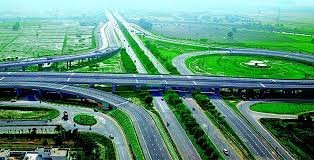India’s Green Highways Initiative with World Bank Aid
Introduction
India has embarked on an ambitious project to construct green highways with the assistance of the World Bank. This initiative aims to integrate environmental considerations into the design, construction, and maintenance of highways across the country. By leveraging international support and innovative practices, India seeks to promote sustainable development and reduce the environmental impact of its infrastructure projects.
The Objective of Green Highways
The primary goal of the Green Highways project is to create eco-friendly road networks that enhance the natural environment. This includes planting trees along highways, utilizing recycled materials in construction, and implementing measures to reduce pollution and carbon emissions. The initiative is part of India’s broader efforts to combat climate change and promote sustainable growth.
World Bank’s Role and Financial Support
The World Bank’s involvement in this project provides crucial financial and technical support. The Bank will offer loans and grants to fund the construction of green highways, ensuring that the latest technologies and best practices are employed. This partnership is expected to significantly boost the efficiency and effectiveness of the project, helping India achieve its environmental and developmental goals.
Implementation Strategy
The implementation of the Green Highways project will be carried out in phases. Initially, the focus will be on pilot projects in selected regions, which will serve as models for broader application. These pilot projects will test various green technologies and practices, allowing for adjustments and improvements before nationwide rollout. The project will also involve extensive training and capacity-building programs for engineers, contractors, and other stakeholders.
Expected Benefits
The Green Highways initiative is anticipated to yield multiple benefits. Environmentally, it will help in carbon sequestration, reduce roadside pollution, and enhance biodiversity. Economically, it will create jobs, promote sustainable tourism, and potentially reduce maintenance costs through the use of durable, eco-friendly materials. Socially, the project aims to improve the quality of life for communities living near highways by providing greener, cleaner environments.
Challenges and Solutions
Despite its many advantages, the Green Highways project faces several challenges. These include high initial costs, the need for advanced technology, and potential resistance from traditional construction sectors. To address these issues, the project will emphasize stakeholder engagement, robust financial planning, and the adoption of a phased implementation approach to manage costs and risks effectively.

Why This News is Important
Environmental Impact
The Green Highways project is a significant step towards reducing India’s carbon footprint. By integrating green practices into highway construction, the initiative helps combat climate change, reduce pollution, and promote biodiversity. These environmental benefits are crucial for the country’s long-term sustainability.
Economic Growth
This project is expected to drive economic growth by creating jobs and promoting industries related to green technologies and sustainable construction. Additionally, the improved infrastructure will facilitate smoother transportation, boosting trade and commerce.
International Collaboration
The collaboration with the World Bank highlights the importance of international partnerships in addressing global challenges. This project sets a precedent for future collaborations, showcasing how developing countries can leverage international expertise and financial support for sustainable development.
Innovation in Infrastructure
The Green Highways initiative represents a significant innovation in infrastructure development. By adopting new technologies and sustainable practices, India is setting an example for other countries, demonstrating that economic growth and environmental conservation can go hand-in-hand.
Historical Context
Background of India’s Infrastructure Development
India has long faced challenges in balancing infrastructure development with environmental conservation. Traditionally, highway construction has been associated with deforestation, pollution, and ecological disruption. The need for a sustainable approach has become increasingly evident as the country strives to meet its developmental goals while addressing environmental concerns.
Previous Initiatives and Policies
Prior to the Green Highways project, India had implemented several policies aimed at promoting sustainable development, such as the National Green Highways Policy (2015), which mandated the planting of trees along national highways. However, these efforts often lacked the financial and technical support required for large-scale implementation.
Role of the World Bank
The World Bank has been a key partner in many of India’s developmental projects, providing both financial aid and technical expertise. Its involvement in the Green Highways project is a continuation of this support, aimed at helping India achieve its sustainability targets through innovative and effective solutions.
Key Takeaways from India’s Green Highways Initiative
| Serial Number | Key Takeaway |
|---|---|
| 1 | India is constructing green highways with World Bank assistance. |
| 2 | The project aims to integrate environmental considerations into highway construction. |
| 3 | The World Bank will provide financial and technical support. |
| 4 | The initiative is expected to yield environmental, economic, and social benefits. |
| 5 | Challenges include high initial costs and the need for advanced technology. |
Important FAQs for Students from this News
1. What is the Green Highways project?
The Green Highways project is an initiative by India, supported by the World Bank, to construct environmentally sustainable highways. It aims to integrate eco-friendly practices into highway construction, including planting trees, using recycled materials, and reducing pollution.
2. What role does the World Bank play in the Green Highways project?
The World Bank provides financial and technical support for the Green Highways project. This includes offering loans and grants to fund the construction and implementation of green technologies and practices.
3. What are the main objectives of the Green Highways project?
The main objectives are to reduce the environmental impact of highway construction, promote sustainable development, enhance biodiversity, and improve the quality of life for communities near highways.
4. How will the Green Highways project be implemented?
The project will be implemented in phases, starting with pilot projects in selected regions. These pilots will test various green technologies and practices before a nationwide rollout.
5. What are some of the expected benefits of the Green Highways project?
The expected benefits include reduced carbon emissions, improved air quality, job creation, economic growth through sustainable tourism, and better quality of life for nearby communities.
Some Important Current Affairs Links


















 Exciting News!
Exciting News!  Join Our Telegram Channel Now!
Join Our Telegram Channel Now!
 Join our Telegram channel for a thrilling adventure into the world of daily current affairs.
Join our Telegram channel for a thrilling adventure into the world of daily current affairs. 
 Don’t miss out on the latest updates and insights! Click to join now and be part of the knowledge revolution!
Don’t miss out on the latest updates and insights! Click to join now and be part of the knowledge revolution! 
